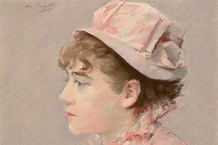Christie's say they will hold single-owner sales and one-off special auctions if the demand arises, but their statement makes it clear that they are effectively pulling out of the market there. Serious consignments are likely to be diverted to salerooms elsewhere and most of their Australasian staff, including their boss Roger McIlroy who has been there for 30 years, will be leaving the company.
So what went wrong? Christie's Australia was established as a representative office in 1969 and elevated to a sales centre in 1989. For the past 11 years they have made a profit and international managing director Lisa King has nothing but praise for the staff and their performance.
The answer, it seems, can be summed up in one word: prospects. With a market expected to top A$160m this year (currently about £70m), Christie's are thought to have turned over only about A$20m in 2005, compared to A$33m for Sotheby's, A$27m for Bonhams and Goodman, and A$24m for Deutsche-Menzies.
Following a strategic review, Christie's board have decided that resources can be put to better use elsewhere. Whatever the profitability in Australia, it contributes only one per cent of the company's global revenue and is unlikely to improve on that performance. With emerging markets in China and elsewhere, they must believe redirecting their efforts will give them greater returns.
Christie's do not publish company results, but rivals Sotheby’s totals may give a clue as to why Christie's feel it is not worth competing in the Australian market any more. Sotheby’s, who have been operating in Australia since 1982, turned over A$34.2m in 2004, but it yielded a pre-tax profit of only A$1.8m.
Christie's final sale, of Australian, International and Contemporary Paintings, will take place in Melbourne on April 10. After that, operations will revert to a similar status as existed pre-1989.
So what about Bonhams and Goodman?
Deutsche-Menzies rationalised the two major strands of their business at the end of 2003 in pursuit of better service and profits. Now Bonhams and Goodman have completely overhauled their annual sales programme, announced in January.
Gone are the 70 auctions conducted by Bonhams and Goodman last year. They are being replaced by four large auctions in Sydney in March, June, September and December, and about 20 smaller sales across the year.
Chief executive Tim Goodman told ATG that the new format would save the firm money, boost profits and provide a better service, while helping them gain market share. Each sale should be able to build enough critical mass to attract an even wider global clientele, helped by promotion from Bonhams’ website and global marketing machine – for the first time the Italian trade have turned up in the saleroom for a sale of 30 Old Masters from a family estate.
Mr Goodman said: "The new format of four big sale events has provided our customers with a more competitive seller's commission structure, a bigger marketing campaign and a much more exciting catalogue and auction experience generally. We are keen to put the excitement and sense of anticipation back into auction sales."
As a result of Christie's decision, Bonhams and Goodman are bringing forward the opening of new headquarters in the centre of Melbourne's fashionable South Yarra. They estimate that over half the Australian fine art market – the biggest growth area in the market – comes out of Melbourne.
Having more than quadrupled in the previous decade, the value of the Australian auction market as a whole has been static at about A$150m since Sydney auctioneers Goodmans merged with Bonhams in September 2003. The growth of fine art has ameliorated the effects of the decline in the decorative arts sector.
Bonhams and Goodman claim pre-eminence in jewellery and collectors cars and will be competing vigorously to capture the A$20m up for grabs now Christie's have withdrawn. They have already made inroads by securing the A$500,000 Weller Collection of 18th century English furniture, for which they competed against Christie's.
Their A$27m turnover for 2005 was a record, up from just A$12m at the time of the merger two years before.
But their success is also due, in part, to expansion through the acquisition last June of Bruce's of Adelaide, the oldest Australian auction business, established by the great grandfather of the current managing director in 1878. And in October last year they announced the further acquisition of Sydney boutique auctioneer Stanley & Co.
The first test for their new condensed sales programme comes on March 26, when over A$10m worth of collectors’ cars, art, jewellery and antique furniture will be offered at Byron Kennedy Hall, near Fox Studios, Sydney.
More than 20,000 people are expected to attend the six days of public viewings and day and evening auctions.
Bonhams and Goodman have also said that they will shortly announce a million dollar deceased estate auction, and on April 22, they will conduct the complete clearing sale of the contents of the Melbourne Tank Museum.
Christie's ditch sales in Australia – Bonhams & Goodmans expand
WHAT'S up Down Under? The very day Christie’s announce that they are downsizing in Australia by ceasing to hold sales there, Bonhams and Goodman say they are expanding operations.




